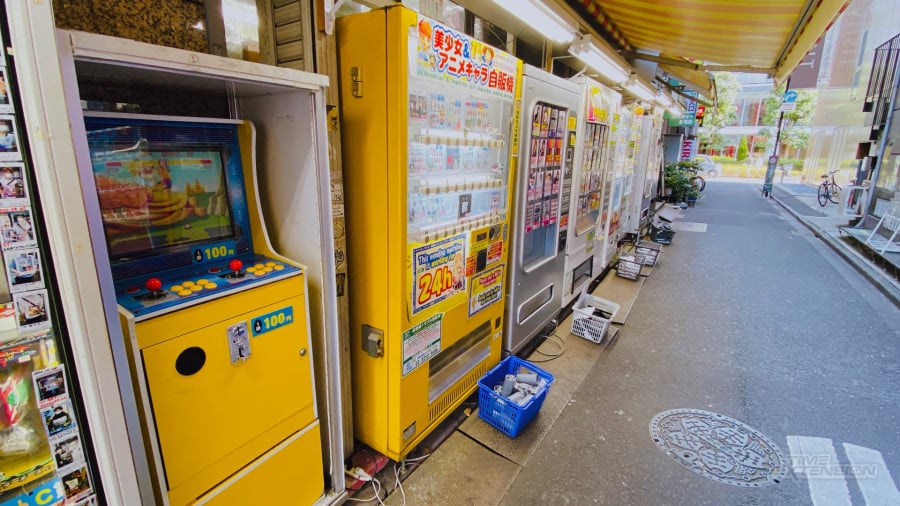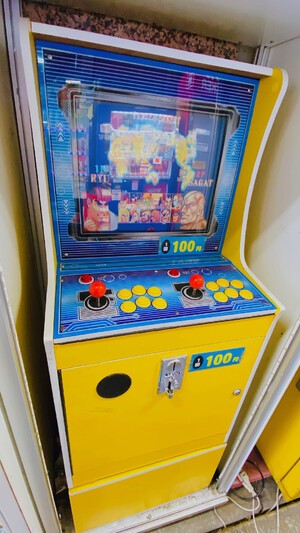
Otaku hotspots fill Tokyo’s iconic nerd neighbourhood, Akihabara. The area’s game shops and arcades are a frequent pilgrimage for retro enthusiasts. While places like Super Potato and GiGO game centres are well-trodden by Akiba regulars and tourists alike, hidden in plain sight is one of the more intriguing old-school oddities: a tiny yellow Street Fighter II cabinet tucked into an alley. Diving into the origins of the cab left me with more questions than answers, but I can at least guide people to experience some actual street fighting.
While dozens of incredible shops fill Akihabara, many notable and tourist-focused stores line the Sotokanda Icchome street right outside the station. Here you will find modern electronics stores like Bic Camera, the GiGO arcades, retro games shops like Traders – plus Liberty, a branch of stores focusing on figurines and toys. Within walking distance of Akihabara Station are seven different Liberty shops, and the company has made Akihabara its home for over thirty years. All shops are numbered, such as Liberty No. 1, though inexplicably there is a No. 11 shop, yet stores 7, 9, and 10 are missing. But if you’re looking for the Street Fighter II cab, you only need to concern yourself with Liberty No. 5.
Right Up Your Alley
The Liberty shops may seem simple and quaint compared to the vibrant storefronts found elsewhere in the area, but it's well-regarded for the impressive stock of figures and rare items. In the alley to the right of the Liberty No. 5 shop is where you will find the aforementioned yellow Street Fighter II cabinet. Placed amongst other vending machines that sell soda, figurines, and idol photographs, it can be easy to miss unless you are specifically looking for it. Ironically, when I encountered the machine, two people were already playing it. The yellow cab seems to be an "if you know, you know" type of thing amongst Akiba regulars. It’s not well-advertised, but if Akiba is your haunt, you will likely stumble upon it eventually.
The origins of the cab are a bit of a mystery. Outside of its striking appearance, another strange thing to note is that it’s actually the Western version of Street Fighter II Champion Edition, as evidenced by its English text and localized names (M. Bison is known as Vega in Japan). Known as Street Fighter II Dash in Japan, this was the first revision of Street Fighter II which included notable additions such as mirror matches and the four playable boss characters.

How Liberty got a western version of the game in a custom cab is anyone’s guess. Photos from 2017 show the cabinet in the same location it is now, yet snapshots from 2018 reveal that Liberty moved the cabinet inside the building’s second floor next to a Raiden cab. Several tweets from 2022 yet again show the cabinet in the alleyway, where it stands as of early 2023.
It’s completely functional and supports two players. The board is straightforward, with a joystick with six buttons in a traditional layout. For one hundred yen, you can try to reach M. Bison and give him the business. I put in two plays, one as Ryu and one as Chun Li, yet was unable to reach the final stage. I blame the screen glare, which there is quite a bit of. But playing Street Fighter in the actual street? No matter how far you advance, it’s worth trying just to say you’ve done such a thing.
Dagashiya, A Retro Hangout Spot
Where the cab came from and how long it’s been in the hands of Liberty may be unknown, but the unusual appearance of the cabinet isn’t. While it’s obviously a custom-built cabinet, this style of arcade cab actually has a long history and unique origins. It’s a 'dagashiya' cab, with dagashiya referring to a very old style of candy store, akin to penny candy stores in the west. Here the sweets are small and cheap; even a ten yen coin nets you something to chew on. A popular hangout for kids back in the day, only a few exist in Japan now as most were run out by convenience stores.
Dagashiya shops were small, cramped, and loaded with things for kids to spend their meagre cash on. Outside of inexpensive candy, many of these shops also had games. Even before the creation of video games, kids could enjoy analogue-style arcade games. Many of these were akin to pinball, or simply dispensed a paper fortune. There is even a museum in Tokyo dedicated to these pre-electronic arcade games. But as technology advanced, many of them were replaced by the likes of Space Invaders, Donkey Kong, and of course, Street Fighter II. Akihabara’s Super Potato has its top floor dedicated to mimicking a Showa-era candy shop, allowing tourists to experience the atmosphere of a dagashiya from a bygone time.

Many dagashiya had generic Blast City or MVS cabs, but others had more compact, customized ones to better utilize space. This yellow Street Fighter II cab is quite narrow, with a smaller screen than most arcade units, and only stands about 150 centimetres, making it easy to shove in a corner. I’ve personally come across them in a few surprising places, such as a Vs. Super Mario Bros. dagashiya cab placed next to a bunch of gacha machines on a random street in Osaka. However, a dagashiya cab has a somewhat nebulous definition as it is also used for customized cocktail cabs where the screen is on the top. So a dagashiya style cab isn’t necessarily a specific make or style, but a term used for an arcade cabinet that evokes playing these games after school with a few yen in your pocket.
Was this yellow Street Fighter II cab spirited away from a now-shuttered candy store? Unlikely, since it is the western version of Street Fighter II and the cabinet looks in too good of shape to have been used for thirty-odd years. Japanese retailers specializing in arcade parts even have special dagashiya-style cabinets for sale. Yet the cabinet’s very existence showcases that while arcades, shops, and even games may drastically change, go out of style, or outright disappear, there will always be those who want to preserve and pay homage to the past so future generations can also experience that same special feeling.
Tokyo Game Life is a Tokyo-based video game podcast focusing on Nintendo and gaming culture in Japan's capital. Tokyo Game Life is available on your favourite podcast app.






Comments 7
This is something I wouldn't really know about, and it certainly isn't important in the grand scheme of things, but I love oddities like this in gaming. Fascinating little story with a bit of culture to go with it. This is one of the wonderful things about this site. Keep it coming, and thank you to the writer.
Man, this is so cool! Going on the list of things to find whenever I someday make my way out east!
What a really interesting piece of gaming history! Thanks again for the great article. This site is the best.
Actually played it in october 2019. Also had a few Bomberman games at Super Potato.
@Ziondood Same, when I go to Japan for the first time (I simply have to considering my interests and even more so that Japanese is my field of study) I'll try to find this, too!
Going back to Japan in November, so will definitely search this out
@Ziondood same! The fact that it's a hidden gem in a back alley makes it even cooler.
Leave A Comment
Hold on there, you need to login to post a comment...